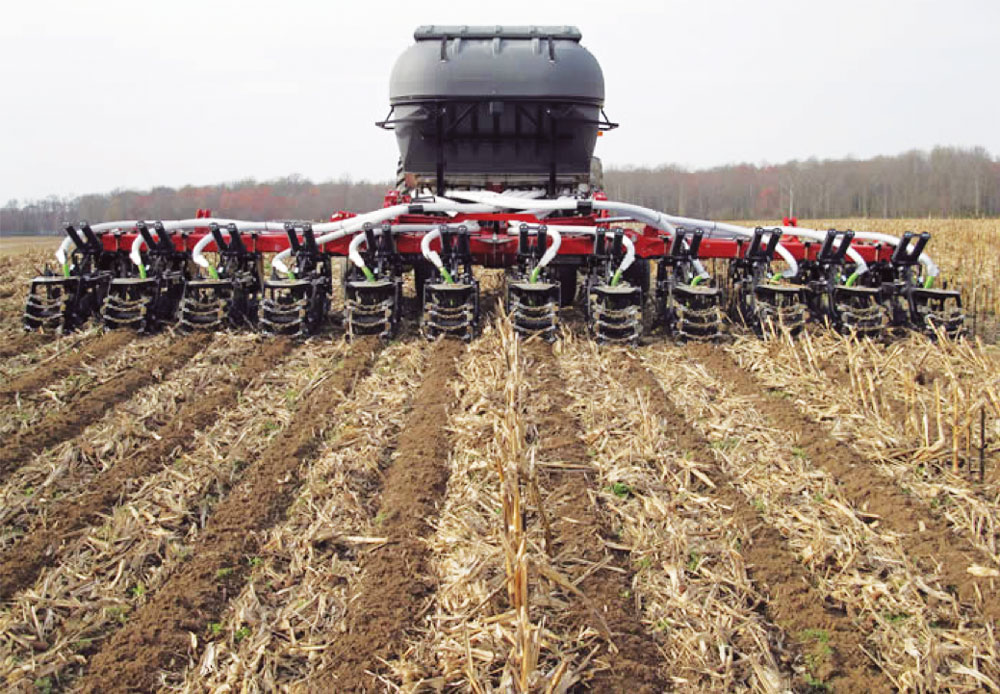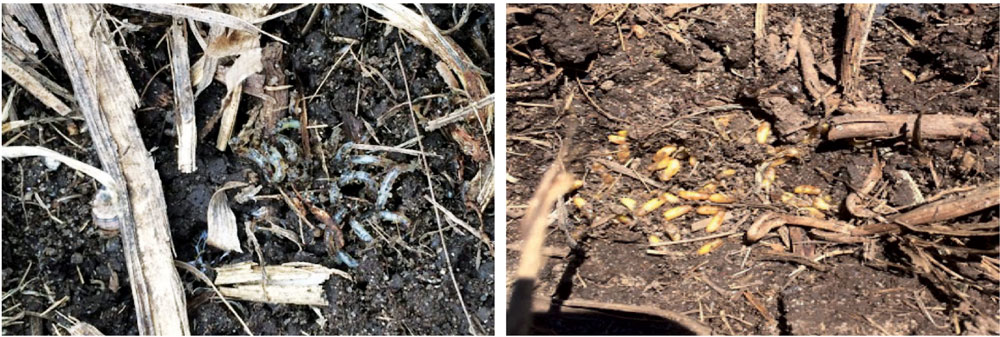The following article is based on Jeff Herrold's presentation at the 2018 National Strip-Tillage Conference. To watch other presentations from the event, click here.
Like all farmers, Jeff Herrold wants high yields. But, he wants to work with nature to achieve them.
Raising strip-tilled corn since 2012 and no-tilled soybeans with his brother, Paul, on their 2,300-acre Wanatah, Ind., farm, Herrold has attacked one obstacle after another striving for 300-bushel corn. In recent years though, he’s begun to refocus on farming profitably first.
Introducing cover crops, leveraging collected field data and managing inputs have all helped fine-tune his strip-till system. Attempting to be strategic in when, how and under what conditions fertilizer is applied has also helped him maximize efficiency.
In 2017, Herrold drilled down on specific data pulled from a 70-acre sample field on his farm. He strip-tilled in spring with a 12-row Kuhn Krause Gladiator and applied a straight rate of fertilizer.
It was followed by a 16-row John Deere 1770 planting corn at populations ranging from 35,000-38,000, depending on soil type. The field was irrigated and contained organic matter rates from 1.8-3.3% — a typical range on Herrold’s farm.

DEEP ROOTS. Jeff Herrold understands the cycling of nutrients where fungi breaks down residue, earthworms take it into the ground and the root exudes back, releasing carbon to feed the microbes. A healthy corn plant is capable of exuding 40% of its carbon.
The field had been strip-tilled continuous corn and cover-cropped with cereal rye for 2 out of the last 4 years. The field’s average yield ended up being about 275-bushels per acre, with some exceptionally productive patches reaching past 300.
Though there were some low spots, consistency in the field was strong. Reverse-engineering what went well, Herrold shares 5 tips and lessons learned from his experimentation for maximizing yield and profitability.
You May Also Be Interested In...
Innovative Opportunities to Increase Soil Biology In Strip-Till
If someone were to hand you a soil test report, would you be able to read the information and understand what it means? Unlock the hidden secrets of accurately deciphering your soil reports. Included in this FREE, 14-page special edition eGuide, readers will have the exciting opportunity to go step-by-step through fluently interpreting a soil test to make accurate decisions on your cropping operation. Download now »
1. Spoon-Feed Fertility
Strip-tilling the 70-acre plot in the spring, Herrold applied a total program of 253 units of nitrogen (N), 73 units of phosphorus (P), 83 units of potassium (K) and 56 units of sulfur.
“It excited me because we didn’t throw a bunch of nitrogen out there and it was corn-on-corn,” Herrold says.
In recent years, Herrold has become a firm believer in spacing fertilizer applications out in order to maximize their plant uptake, while also marginally dialing back rates. Data pulled from his field indicates his cation-exchange capacity (CEC) values — measuring the retention of soil particles — are low, making split applications particularly important.
“When we’re timing our nitrogen, we’re applying at pre-plant, planting, sidedress and during irrigation,” says Herrold. “We do it four different times because our soils can’t handle a lot at one time. This way, we’re also better stewards of what we have because it reduces leaching and prevents murking up our groundwater.”
During irrigation, Herrold will fertigate 50 units per acre of K through the center pivot. “I see potassium as a really important thing as it is the money-mineral and our plant is a luxury up-taker of potassium,” he says.
2. Target the Row
In addition to timing applications, placement is equally important. Banding about 50 pounds per acre of potash during the initial spring strip-till pass has gradually led to a reduction in the total fertilizer applications during the year, Herrold says.

ROW COVER. Indiana farmer Jeff Herrold took the row cleaners off his 12-row Kuhn Krause Gladiator strip-till rig in an attempt to protect soils from “crusting over.” When he comes back with his 16-row John Deere 1770 planter, its row cleaners push away the remaining residue.
“When we started putting fertilizer in the row, we were excited because we thought our corn yields were going to jump like crazy, but we didn’t really see the jump,” he adds. “But, we’ve started using less fertilizer without seeing a reduction in yield. We started off with a 15% reduction — and we’re not doing anymore fertilizer spreading at all. We’ve recently brought it even down more to about 35% less with similar results.”
3. Balance Bacteria, Bugs & Fungi
It wasn’t long ago that Herrold’s understanding of soil biology was fairly basic, he admits. However, an appreciation of the soil food web — the community of organisms living all or part of their lives in the soil — has opened doors to increased productivity and cost cutting.
“I used to think you planted corn, put some starter on, a little nitrogen down, water it and then let the sun shine to get a corn plant,” he says. “But understanding how the system is connected in this soil food web is helpful. The plant is taking in sunlight and exuding carbon. It’s feeding the organic matter and fungi. Then the nematodes go after your roots but the fungi goes after nematodes and traps them. There are also beneficial nematodes going after the other ones. Then there is protozoa keeping bacteria in check. Everything is connected.”
Herrold argues that farmers have “outsourced” the job of maintaining healthy soils, that nature instinctively wants to accomplish on its own, to chemical solutions. To reemploy nature in this capacity, Herrold says an ideal strip-till system will till as little as possible, grow a variety of plants, keep living plants in the soil for as long as possible and keep the soil surface covered with residue.

BIOLOGICAL WARFARE. Jeff Herrold says there is a temptation to use chemical solutions on fields where natural ones exist. Recalling an instance in which armyworms started showing up on his field (left), he waited while neighbors responded by spraying Baythroid. A few days later, the pests had all but died (right) because “beneficial nematodes” had killed them off, he says.
“We want to see healthy soil that’s converting nutrients and feeding the plants — that’s been our path to high yields and high profit,” he says. “I can go into my field and see the haystacks, see the burrows, the earthworms moving around. What do earthworms do? They can excrete 100 tons per-inch of manure, 4 pounds of nitrogen, 30 pounds of phosphorous, 70 pounds of potassium and 500 pounds of calcium.”
Knowing the theoretical underpinnings behind healthy soil is one thing, but putting them into action is another. Herrold admits that certain chemical solutions, such as fungicide, have be hard to pull away from. Little by little though, he’s beginning to realize input cost savings.
“I’m growing corn-on-corn so I’m going to get more disease pressure,” he says. “But the deeper I get into the system, the healthier plants I get and ultimately the more disease I will be able to suppress. In 2018, we did a lot of non-fungicide fields, but on our best corn, I still did two applications of fungicide.”
Understanding the food web, Herrold recalls an instance in which armyworms started showing up on his field. While neighbors immediately responded by spraying Baythroid, Herrold waited a few days to see how his soil’s ecosystem would respond to the pest.
“Two days later I came out and dug to find a ton of dead armyworms,” he says. “What killed them? The beneficial nematodes. Mother Nature showed up, with its own solution.”
Although he’ll still employ insecticides and fungicide occasionally, he suspects the applications work to destroy the balance in the soil in favor of short-term gain. Dialing back these applications not only saves inputs costs, but time, fuel and equipment wear and tear.
4. Rethink Testing
Healthy soil is constantly cycling nutrients back and forth from the root structure of the crop and the biome beneath it, explains Herrold. Because of this, it stands to reason that an ordinary soil test of healthy soil may not always be an accurate reflection of the system’s nutrient needs.
“As my soil is converting nutrients, a soil test could show low nitrogen while the plant itself is not deficient,” he says. “I may not find the nutrients in the soil test because everything was tied up in the microbes. I’m not solely basing decisions on a soil test now, and they are really a small component used to judge my soil health.”

"A healthy corn plant is capable of exuding 40% of its carbon. It’s feeding the bacteria and fungi below, knowing that it will get phosphorus, water and nutrients in return..." — Jeff Herrold
Though just starting to apply the practice, Herrold suggests using Haney tests in conjunction with other barometers of soil health to get a fuller picture of soil health. These tests are designed to measure both nitrate and ammoniacal N and estimate what will be released from water-soluble organic N during the season.
“We’re starting to project what’s going to be released in the soil,” he says. “I can tell by your activity how much microbial active carbon is remaining.”
Tissue sampling is another part of the mix, he says. “We’re taking tissue samples about 4 times a year, depending on the crop,” Herrold says. “I need to see what’s going on inside the plant as well, making sure the nutrients are getting in.”
5. Monitor Residue
A surplus or dearth of crop residue can be problematic, but to some extent it can be an indicator of soil health. On Herrold’s healthiest fields, residue is dealt with naturally and quickly, he says, even on continuous corn.
“Residue is gone quickly as the soil converts it,” he says. “My fungi breaks it down, earthworms take it into the ground and exude it to feed the crop. Then the root exudes back, releasing carbon to feed the microbes.
“A healthy corn plant is capable of exuding 40% of its carbon,” Herrold says. “It’s feeding the bacteria and fungi below, knowing that it’ll get phosphorus, water and nutrients in return.”
Not using a chopping corn head on his combine, Herrold notes that it’s still important to make an equal distribution of residue across the field.
“Residue management is really important — I know where I stop with the combine is going to be a spot with poorer yield,” he says. “But, if our systems are working really well, we won’t be able to find leftover cornstalks to drive alongside in the field.”
Herrold notes that residue often disappears from his fields so quickly that he actively tries to toss some of it back on top of his strips.
“On our strip-tiller, I’m trying to put more residue in my strip so I leave it covered and it’s not susceptible to crusting over,” he says. “To do this, I took our row cleaners off. It leaves all that residue in the middle, and then my planter will come in, and wipe just enough of that residue away.”
Learn More
21 Strip-Till Fertility Tips for Feeding Plants the Right Diet
Split nitrogen applications, determining the proper placement depth and doing below-ground root assessments are all part of a well-rounded fertility program.







